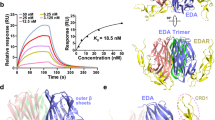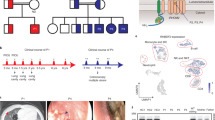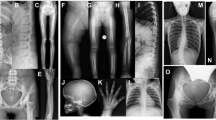Abstract
The molecular basis of X-linked recessive anhidrotic ectodermal dysplasia with immunodeficiency (EDA-ID) has remained elusive. Here we report hypomorphic mutations in the gene IKBKG in 12 males with EDA-ID from 8 kindreds, and 2 patients with a related and hitherto unrecognized syndrome of EDA-ID with osteopetrosis and lymphoedema (OL-EDA-ID). Mutations in the coding region of IKBKG are associated with EDA-ID, and stop codon mutations, with OL-EDA-ID. IKBKG encodes NEMO, the regulatory subunit of the IKK (IκB kinase) complex, which is essential for NF-κB signaling. Germline loss-of-function mutations in IKBKG are lethal in male fetuses. We show that IKBKG mutations causing OL-EDA-ID and EDA-ID impair but do not abolish NF-κB signaling. We also show that the ectodysplasin receptor, DL, triggers NF-κB through the NEMO protein, indicating that EDA results from impaired NF-κB signaling. Finally, we show that abnormal immunity in OL-EDA-ID patients results from impaired cell responses to lipopolysaccharide, interleukin (IL)-1β, IL-18, TNFα and CD154. We thus report for the first time that impaired but not abolished NF-κB signaling in humans results in two related syndromes that associate specific developmental and immunological defects.
This is a preview of subscription content, access via your institution
Access options
Subscribe to this journal
Receive 12 print issues and online access
$209.00 per year
only $17.42 per issue
Buy this article
- Purchase on SpringerLink
- Instant access to full article PDF
Prices may be subject to local taxes which are calculated during checkout





Similar content being viewed by others
References
Pinheiro, M. & Freire-Maia, N. Ectodermal dysplasias: a clinical classification and a causal review. Am. J. Med. Genet. 53, 153–162 (1994).
Kere, J. et al. X-linked anhidrotic (hypohidrotic) ectodermal dysplasia is caused by mutation in a novel transmembrane protein. Nature Genet. 13, 409–416 (1996).
Ezer, S., Bayes, M., Elomaa, O., Schlessinger, D. & Kere, J. Ectodysplasin is a collagenous trimeric type II membrane protein with a tumor necrosis factor-like domain and co-localizes with cytoskeletal structures at lateral and apical surfaces of cells. Hum. Mol. Genet. 8, 2079–2086 (1999).
Monreal, A.W. et al. Mutations in the human homologue of mouse dl cause autosomal recessive and dominant hypohidrotic ectodermal dysplasia. Nature Genet. 22, 366–369 (1999).
Frix, C.D.d. & Bronson, D.M. Acute miliary tuberculosis in a child with anhidrotic ectodermal dysplasia. Pediatr. Dermatol. 3, 464–467 (1986).
Sitton, J.E. & Reimund, E.L. Extramedullary hematopoiesis of the cranial dura and anhidrotic ectodermal dysplasia. Neuropediatrics 23, 108–110 (1992).
Abinun, M., Spickett, G., Appleton, A.L., Flood, T. & Cant, A.J. Anhidrotic ectodermal dysplasia associated with specific antibody deficiency. Eur. J. Pediatr. 155, 146–147 (1996).
Schweizer, P., Kalhoff, H., Horneff, G., Wahn, V. & Diekmann, L. Polysaccharide specific humoral immunodeficiency in ectodermal dysplasia. Case report of a boy with two affected brothers. Klin. Padiatr. 211, 459–461 (1999).
Brooks, E.G. et al. Thymic hypoplasia and T-cell deficiency in ectodermal dysplasia: case report and review of the literature. Clin. Immunol. Immunopathol. 71, 44–52 (1994).
Jhaveri, M., Barnett, S.H., Gertner, M., Rho, Y.M. & Segen, J.C. Ectrodactyly, ectodermal dysplasia, and clefting associated with thymic aplasia. Am. J. Dis. Child. 143, 12 (1989).
IUIS. Primary immunodeficiency diseases. Report of an IUIS Scientific Committee. International Union of Immunological Societies. Clin. Exp. Immunol. 118, 1–28 (1999).
Masse, J.F. & Perusse, R. Ectodermal dysplasia. Arch. Dis. Child. 71, 1–2 (1994).
Abinun, M. Ectodermal dysplasia and immunodeficiency. Arch. Dis. Child. 73, 185 (1995).
McKusick, V.A. Mendelian Inheritance in Man. Catalogs of Human Genes and Genetic Disorders (Johns Hopkins University Press, Baltimore, 1998).
Smahi, A. et al. Genomic rearrangement in NEMO impairs NF-κB activation and is a cause of incontinentia pigmenti. The International Incontinentia Pigmenti (IP) Consortium. Nature 405, 466–472 (2000).
Francis, J.S. & Sybert, V.P. Incontinentia pigmenti. Semin. Cutan. Med. Surg. 16, 54–60 (1997).
Karin, M. & Ben-Neriah, Y. Phosphorylation meets ubiquitination: the control of NF-κB activity. Annu. Rev. Immunol. 18, 621–663 (2000).
Yamaoka, S. et al. Complementation cloning of NEMO, a component of the IκB kinase complex essential for NF-κB activation. Cell 93, 1231–1240 (1998).
Rothwarf, D.M., Zandi, E., Natoli, G. & Karin, M. IKK-γ is an essential regulatory subunit of the IκB kinase complex. Nature 395, 297–300 (1998).
Israel, A. The IKK complex: an integrator of all signals that activate NF-κB? Trends Cell Biol. 10, 129–133 (2000).
Rudolph, D. et al. Severe liver degeneration and lack of NF-κB activation in NEMO/IKKγ-deficient mice. Genes Dev. 14, 854–862 (2000).
Schmidt-Supprian, M. et al. NEMO/IKK γ-deficient mice model incontinentia pigmenti. Mol. Cell 5, 981–992 (2000).
Makris, C. et al. Female mice heterozygous for IKK γ/NEMO deficiencies develop a dermatopathy similar to the human X-linked disorder incontinentia pigmenti. Mol. Cell 5, 969–979 (2000).
Courtois, G., Whiteside, S.T., Sibley, C.H. & Israel, A. Characterization of a mutant cell line that does not activate NF-κB in response to multiple stimuli. Mol. Cell. Biol. 17, 1441–1449 (1997).
Headon, D.J. & Overbeek, P.A. Involvement of a novel TNF receptor homologue in hair follicle induction. Nature Genet. 22, 370–374 (1999).
O'Neill, L.A. & Dinarello, C.A. The IL-1 receptor/toll-like receptor superfamily: crucial receptors for inflammation and host defense. Immunol. Today 21, 206–209 (2000).
Tominaga, K. et al. IL-12 synergizes with IL-18 or IL-1β for IFN-γ production from human T cells. Int. Immunol. 12, 151–160 (2000).
Goldfeld, A.E., Doyle, C. & Maniatis, T. Human tumor necrosis factor α gene regulation by virus and lipopolysaccharide. Proc. Natl. Acad. Sci. USA 87, 9769–9773 (1990).
Poltorak, A. et al. Genetic and physical mapping of the Lps locus: identification of the toll-4 receptor as a candidate gene in the critical region. Blood Cells Mol. Dis. 24, 340–355 (1998).
van Kooten, C. & Banchereau, J. CD40-CD40 ligand. J. Leukoc. Biol. 67, 2–17 (2000).
Lane, P. et al. Activated human T cells express a ligand for the human B cell-associated antigen CD40 which participates in T cell-dependent activation of B lymphocytes. Eur. J. Immunol. 22, 2573–2578 (1992).
Berberich, I., Shu, G.L. & Clark, E.A. Cross-linking CD40 on B cells rapidly activates nuclear factor-κB. J. Immunol. 153, 4357–4366 (1994).
Cella, M. et al. Ligation of CD40 on dendritic cells triggers production of high levels of interleukin-12 and enhances T cell stimulatory capacity: T-T help via APC activation. J. Exp. Med. 184, 747–752 (1996).
Zonana, J. Hypohidrotic (anhidrotic) ectodermal dysplasia: molecular genetic research and its clinical applications. Semin. Dermatol. 12, 241–246 (1993).
Franzoso, G. et al. Requirement for NF-κB in osteoclast and B-cell development. Genes Dev. 11, 3482–3496 (1997).
Hsu, H. et al. Tumor necrosis factor receptor family member RANK mediates osteoclast differentiation and activation induced by osteoprotegerin ligand. Proc. Natl. Acad. Sci. USA 96, 3540–3545 (1999).
Dougall, W.C. et al. RANK is essential for osteoclast and lymph node development. Genes Dev. 13, 2412–2424 (1999).
Karkkainen, M.J. et al. Missense mutations interfere with VEGFR-3 signaling in primary lymphoedema. Nature Genet. 25, 153–159 (2000).
Medzhitov, R. & Janeway, C., Jr. Innate immunity. N. Engl. J. Med. 343, 338–344 (2000).
Kuhns, D.B., Long Priel, D.A. & Gallin, J.I. Endotoxin and IL-1 hyporesponsiveness in a patient with recurrent bacterial infections. J. Immunol. 158, 3959–3964 (1997).
Hoshino, K. et al. Toll-like receptor 4 (TLR4)-deficient mice are hyporesponsive to lipopolysaccharide: evidence for TLR4 as the Lps gene product. J. Immunol. 162, 3749–3752 (1999).
Levy, J. et al. Clinical spectrum of X-linked hyper-IgM syndrome. J. Pediatr. 131, 47–54 (1997).
Takeuchi, O. et al. Differential roles of TLR2 and TLR4 in recognition of gram-negative and gram-positive bacterial cell wall components. Immunity 11, 443–451 (1999).
Yoshimura, A. et al. Recognition of Gram-positive bacterial cell wall components by the innate immune system occurs via Toll-like receptor 2. J. Immunol. 163, 1–5 (1999).
Jouanguy, E. et al. IL-12 and IFN-γ in host defense against mycobacteria and Salmonella in mice and men. Curr. Opin. Immunol. 11, 346–351 (1999).
Means, T.K. et al. Human toll-like receptors mediate cellular activation by Mycobacterium tuberculosis. J. Immunol. 163, 3920–3927 (1999).
Underhill, D.M., Ozinsky, A., Smith, K.D. & Aderem, A. Toll-like receptor-2 mediates mycobacteria-induced proinflammatory signaling in macrophages. Proc. Natl. Acad. Sci. USA 96, 14459–14463 (1999).
Zonana, J. et al. A novel X-linked disorder of immune deficiency and hypohidrotic ectodermal dysplasia is allelic to incontinentia pigmenti and due to mutations in IKK-γ (NEMO). Am. J. Hum. Genet. 67, 1555–1562 (2000).
Kumar, A., Eby, M.T., Sinha, S., Jasmin, A. & Chaudhary, P.M. Ectodermal dysplasia receptor activates the nuclear factor κ B, c-Jun N-terminal kinase and cell death pathways and binds to ectodysplasmin A. J. Biol. Chem. 276, 2668–2677 (2000).
Yan, M. et al. Two-amino acid molecular switch in an epithelial morphogen that regulates binding to two distinct receptors. Science 290, 523–527 (2000).
Acknowledgements
We thank P. Darocca, G. Barcenas-Döffinger, M. Feinberg, P. Revy, G. de Saint Basile, P. Darbyshire, C. Moss and J. Clarke. J.-L.C. thanks J.-C. Weill for encouragement and support. This work was supported by grants from Faculté Necker, Université de Paris René Descartes, Fondation Schlumberger, Fondation Jean Valade, Legs Poix, FRM, Fondation BNP-Parisbas, PNRFMMIP, Institut Universitaire de France, National Incontinentia Pigmenti Foundation, Action Incitative Blanche and INSERM U550 to J.-L.C.
Author information
Authors and Affiliations
Corresponding authors
Rights and permissions
About this article
Cite this article
Döffinger, R., Smahi, A., Bessia, C. et al. X-linked anhidrotic ectodermal dysplasia with immunodeficiency is caused by impaired NF-κB signaling. Nat Genet 27, 277–285 (2001). https://doi.org/10.1038/85837
Received:
Accepted:
Issue Date:
DOI: https://doi.org/10.1038/85837
This article is cited by
-
Monogenic inflammatory bowel disease-genetic variants, functional mechanisms and personalised medicine in clinical practice
Human Genetics (2023)
-
Börjeson–Forssman–Lehmann syndrome: delineating the clinical and allelic spectrum in 14 new families
European Journal of Human Genetics (2023)
-
Low Density Granulocytes and Dysregulated Neutrophils Driving Autoinflammatory Manifestations in NEMO Deficiency
Journal of Clinical Immunology (2022)
-
Primary lymphoedema
Nature Reviews Disease Primers (2021)
-
Analysis of IKBKG/NEMO gene in five Japanese cases of incontinentia pigmenti with retinopathy: fine genomic assay of a rare male case with mosaicism
Journal of Human Genetics (2021)



